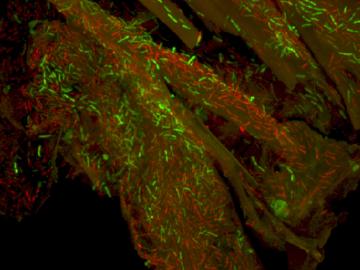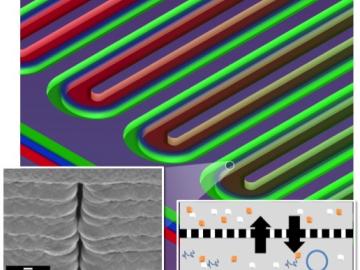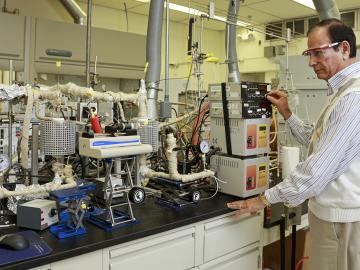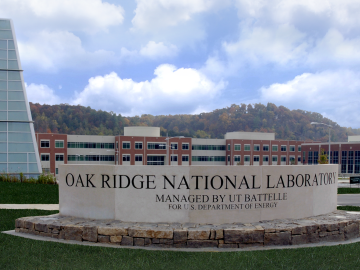
Filter News
Area of Research
- (-) Clean Energy (187)
- (-) Materials for Computing (13)
- Advanced Manufacturing (14)
- Biological Systems (15)
- Biology and Environment (42)
- Biology and Soft Matter (1)
- Building Technologies (3)
- Chemistry and Physics at Interfaces (4)
- Climate and Environmental Systems (2)
- Computational Biology (4)
- Computational Engineering (2)
- Computer Science (6)
- Electricity and Smart Grid (1)
- Energy Frontier Research Centers (7)
- Energy Sciences (3)
- Fossil Energy (2)
- Fuel Cycle Science and Technology (1)
- Functional Materials for Energy (8)
- Fusion and Fission (19)
- Fusion Energy (2)
- Geographic Information Science and Technology (2)
- Isotope Development and Production (1)
- Isotopes (10)
- Materials (226)
- Materials Characterization (2)
- Materials Synthesis from Atoms to Systems (5)
- Materials Under Extremes (5)
- National Security (25)
- Neutron Science (80)
- Nuclear Science and Technology (27)
- Nuclear Systems Modeling, Simulation and Validation (1)
- Nuclear Systems Technology (1)
- Quantum Condensed Matter (1)
- Quantum information Science (2)
- Reactor Technology (1)
- Sensors and Controls (1)
- Supercomputing (115)
- Transportation Systems (5)
News Type
News Topics
- 3-D Printing/Advanced Manufacturing (31)
- Advanced Reactors (4)
- Artificial Intelligence (5)
- Big Data (3)
- Bioenergy (14)
- Biology (5)
- Biomedical (3)
- Biotechnology (2)
- Buildings (10)
- Chemical Sciences (13)
- Clean Water (1)
- Climate Change (7)
- Composites (6)
- Computer Science (10)
- Coronavirus (4)
- Critical Materials (4)
- Cybersecurity (3)
- Decarbonization (12)
- Energy Storage (28)
- Environment (19)
- Exascale Computing (2)
- Fossil Energy (1)
- Frontier (2)
- Fusion (1)
- Grid (11)
- High-Performance Computing (3)
- Isotopes (2)
- Machine Learning (5)
- Materials (20)
- Materials Science (16)
- Mercury (1)
- Microscopy (5)
- Molten Salt (1)
- Nanotechnology (6)
- National Security (5)
- Net Zero (1)
- Neutron Science (11)
- Nuclear Energy (4)
- Partnerships (8)
- Physics (1)
- Polymers (7)
- Quantum Science (2)
- Renewable Energy (1)
- Security (4)
- Simulation (2)
- Space Exploration (1)
- Summit (3)
- Sustainable Energy (28)
- Transformational Challenge Reactor (3)
- Transportation (20)
Media Contacts

A 20-kilowatt wireless charging system demonstrated at the Department of Energy’s Oak Ridge National Laboratory has achieved 90 percent efficiency at three times the rate of the plug-in systems commonly used for electric vehicles today. This ability can help acc...

Researchers at the Department of Energy’s Oak Ridge National Laboratory have demonstrated a production method they estimate will reduce the cost of carbon fiber as much as 50 percent and the energy used in its production by more than 60 percent. After extensive ...

Experts at the U.S. Department of Energy’s Oak Ridge National Laboratory will help nine small companies move their innovative manufacturing, buildings, fuel cell, geothermal and vehicle technologies closer to the marketplace. The businesses are among 33 selected t...

Three U.S. Department of Energy-funded research centers – the BioEnergy Science Center (Oak Ridge National Laboratory), the Great Lakes Bioenergy Research Center (University of Wisconsin–Madison and Michigan State University), and the Joint BioEnergy Institute (Lawrence Berkeley National Laboratory) – are making progress on a shared mission to develop technologies that will bring advanced biofuels to the marketplace, reporting today the disclosure of their 500th invention.




Researchers at the Department of Energy’s Oak Ridge National Laboratory have received six R&D 100 Awards, increasing the lab’s total to 193 since the award’s inception in 1963. The competition, sponsored by R&D Magazine, recognizes advances in the nation’s ...

A new study from the Department of Energy’s Oak Ridge National Laboratory explains the mechanism behind a technology that converts bio-based ethanol into hydrocarbon blend-stocks for use as fossil fuel alternatives. Scientists have experimented for decades with a cl...



